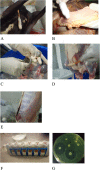Escherichia coli O157:H7: distribution, molecular characterization, antimicrobial resistance patterns and source of contamination of sheep and goat carcasses at an export abattoir, Mojdo, Ethiopia
- PMID: 31510932
- PMCID: PMC6740007
- DOI: 10.1186/s12866-019-1590-8
Escherichia coli O157:H7: distribution, molecular characterization, antimicrobial resistance patterns and source of contamination of sheep and goat carcasses at an export abattoir, Mojdo, Ethiopia
Abstract
Background: Cattle have been identified as a major reservoir of E. coli O157:H7 for human infection; the ecology of the organism in sheep and goats is less understood. This study was carried out to determine prevalence, source of infection, antibiotic resistance and molecular characterization of Escherichia coli O157: H7 isolated from sheep and goat.
Methods: Systematic random sampling was carried out at Modjo export abattoir, Ethiopia, from November 2012 to April 2013 to collect 408 samples from 72 sheep and 32 goats. Samples collected were skin swabs, fecal samples, intestinal mucosal swabs and the inside and outside part of carcasses as well as carcass in contacts such as workers hands, knife, hook and carcass washing water. Then, samples were processed following standard bacteriological procedures. Non-Sorbitol fermenting colonies were tested on latex agglutination test and the positives are subjected to PCR for detection of attaching and effacing genes (eaeA) and shiga toxin producing genes (stx1 and stx2). All E. coli O157:H7 isolates were checked for their susceptibility pattern towards 15 selected antibiotics.
Results: E. coli O157:H7 were detected in only 20/408 samples (4.9%). Among these 20 positive samples, 70% (14/20), 25% (5/20) and 5% (1/20) were from sheep, goats and knife samples, respectively. No significant associations were found between carcasses and the assumed sources of contaminations. Of all the 20 isolates virulence genes were found in 10 (50%) of them; 3 (15%) with only the eaeA gene and 7(35%) expressing eaeA and stx2 genes. All the isolates were susceptible to Norfloxacin (NOR) (100%).
Conclusions: The presence of virulence genes shows E. coli O157:H7 is a potential source of human infection in Ethiopia.
Keywords: Abattoir; Antibiotic sensitivity; CT-SMAC; E. coli O157:H7; IMS; Latex agglutination; Multiplex PCR.
Conflict of interest statement
No conflict of interest declared.
Figures



References
-
- Reid C, Small A, Avery S, Buncic S. Presence of foodborne pathogens on cattle hides. Food Control. 2002;13:411–415. doi: 10.1016/S0956-7135(01)00050-0. - DOI
-
- Hajian S, Rahimi E, Mommtaz H. A 3 year study of Escherichia coli O157:H7 in cattle, camel, sheep, goat, chicken and beef minced meat. Int Conf Food Eng Biotechnol. 2011;9:163–165.
-
- Fratamico P, Smith J. Escherichia coli infections. In: Riemann H, Cliver D, editors. Food borne infections and intoxications. 3. New York: Elsevier science; 2006.
Publication types
MeSH terms
Substances
LinkOut - more resources
Full Text Sources
Medical
Miscellaneous

